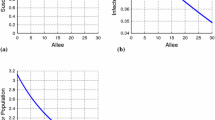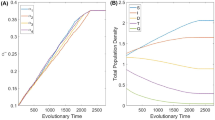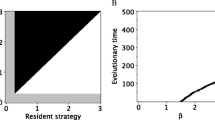Abstract
We analyze the effect of sterilization in the infected hosts in several epidemiological models involving infectious diseases that can be transmitted both vertically and horizontally. Sterilizing pathogens can be used as pest control agents by intentionally inoculating the target population, with the goal of reducing or eliminating it completely. Contrary to previous models that did not include vertical transmission we found that the population size at the endemic equilibrium may actually increase with higher levels of sterility. This effect is proved to exist for low to high efficiencies of vertical transmission. On the other hand, if the disease is sexually transmitted and the host reproduction and disease transmission are both consistently mediated by mating, we do not observe such a counter-intuitive effect and the population size in the stable endemic equilibrium is decreasing with higher levels of sterility. We suggest that models of the pest control techniques involving the release of sterilizing pathogens have to carefully consider the routes such pathogens use for transmission.





Similar content being viewed by others
References
Adams B, Boots M (2010) How important is vertical transmission in mosquitoes for the persistence of dengue? Insights from a mathematical model. Epidemics 2:1–10
Altizer SM, Augustine DJ (1997) Interactions between frequency-dependent and vertical transmission in host-parasite systems. Proc R Soc B 264:807–814
Berec L, Maxin D (2012) Double impact of sterilizing pathogens: added value of increased life expectancy on pest control effectiveness. J Math Biol 64:1281–1311. doi:10.1007/s00285-011-0449-x
Berec L, Maxin D (2013) Fatal or harmless: extreme bistability induced by sterilizing, sexually transmitted pathogens. Bull Math Biol 75:258–273
Bernhauerova V, Berec L (2014) Evolution of pathogen transmission under trade-off between sexual and vertical modes (in revision)
Boukal DS, Berec L (2002) Single-species models of the Allee effect: extinction boundaries, sex ratios and mate encounters. J Theor Biol 218:375–394
Castillo-Chavez C, Huang W (1995) The logistic equation revisited: the two-sex case. Math Biosci 128:299–316
Caswell H, Weeks DE (1986) Two-sex models: chaos, extinction, and other dynamic consequences of sex. Am Nat 128:707–735
Cory JS, Myers JH (2003) The ecology and evolution of insect baculoviruses. Annu Rev Ecol Evol Syst 34:239–272
Courchamp F, Chapuis JL, Pascal M (2003) Mammal invaders on islands: impact, control and control impact. Biol Rev 78:347–383
Courchamp F, Berec L, Gascoigne J (2008) Allee effects in ecology and conservation. Oxford University Press, Oxford
Deredec A, Berec L, Boukal DS, Courchamp F (2008) Are non-sexual models appropriate for predicting the impact of virus-vectored immunocontraception? J Theor Biol 250:281–290
Ebenhard T (1988) Introduced birds and mammals and their ecological effects. Swed Wildl Res 13:1–107
Frances SP, Watcharapichat P, Phulsuksombati D (2001) Vertical transmission of Orientia tsutsugamushi in two lines of naturally infected \(Leptotrombidium\, deliense\) (Acari: Trombiculidae). J Med Entomol 38:17–21
Fuxa JR, Richter AR, Ameen AO, Hammock BD (2002) Vertical transmission of TnSNPV, TnCPV, AcMNPV, and possibly recombinant NPV in \(Trichoplusia\, ni\). J Invertebr Pathol 79:44–50
Hadeler KP, Waldstätter R, Wörz-Busekros A (1988) Models for pair formation in bisexual populations. J Math Biol 26:635–649
Haine ER, Pickup NJ, Cook JM (2005) Horizontal transmission of Wolbachia in a \(Drosophila\) community. Ecol Entomol 30:464–472
Hardy CM, Hinds LA, Kerr PJ, Lloyd ML, Redwood AJ, Shellam GR, Strive T (2006) Biological control of vertebrate pests using virally vectored immunocontraception. J Reprod Immunol 71:102–111
Hirunkanokpun S, Carlson JO, Kittayapong P (2008) Evaluation of mosquito densoviruses for controlling \(Aedes \,aegypti\) (Diptera: Culicidae): variation in efficiency due to virus strain and geographic origin of mosquitoes. Am J Trop Med Hyg 78:784–790
Iannelli M, Martcheva M, Milner FA (2005) Gender-structured population modeling. SIAM, Philadelphia
Kukan B (1999) Vertical transmission of nucleopolyhedrovirus in insects. J Invertebr Pathol 74:103–111
Lindström J, Kokko H (1998) Sexual reproduction and population dynamics: the role of polygyny and demographic sex differences. Proc R Soc Lond B 265:483–488
Lipsitch M, Nowak MA, May RM (1995) The population dynamics of vertically and horizontally transmitted parasites. Proc R Soc B 260:321–327
Lockwood JL, Hoopes M, Marchetti M (2007) Invasion ecology. Blackwell Publishing Ltd., Malden
Miller MR, White A, Wilson K, Boots M (2007) The population dynamical implications of male-biased parasitism in different mating systems. PLoS One 7:e624
Miller TEX, Inouye BD (2011) Confronting two-sex demographic models with data. Ecology 92:2141–2151
Miller TEX, Inouye BD (2013) Sex and stochasticity affect range expansion of experimental invasions. Ecol Lett 16:354–361
Pugliese A (1990) Population models for diseases with no recovery. J Math Biol 28:65–82
Rankin DJ, Kokko H (2007) Do males matter? The role of males in population dynamics. Oikos 116:335–348
Tyndale-Biscoe CH (1994) Virus-vectored immunocontraception of feral mammals. Reprod Fertil Dev 6:281–287
Vitousek PM, Dantonio CM, Loope LL, Rejmanek M, Westbrooks R (1997) Introduced species: a significant component of human-caused global change. N Z J Ecol 21:1–16
Zhou J, Hethcote HW (1994) Population size dependent incidence in models for diseases without immunity. J Math Biol 32:809–834
Acknowledgments
LB acknowledges institutional support RVO:60077344. DM acknowledges funding from Wheat Ridge Ministries—O. P. Kretzmann Grant for Research in the Healing Arts and Sciences. This work was also partially supported by NSF Grant DMS-0851721. The authors wish to thank the reviewers for their reports that helped improve the exposition of the paper.
Author information
Authors and Affiliations
Corresponding author
Appendices
Appendix: Proof of Theorem \(1\)
With \(\varPhi (N)=\lambda \), the expression (3) implies
Its derivative with respect to \(\sigma \) is
with
This function has two roots (which are the critical values of \(\frac{dN^*}{d\sigma }\)):
If these roots are complex, i.e if \(\lambda >\alpha +\beta \), then \(h(\sigma )>0\) on its entire domain and \(N^*\) is increasing with \(\sigma \). In what follows we assume that \(\hat{\sigma }\) and \(\bar{\sigma }\) are real, that is, \(\lambda <\alpha +\beta \). Combined with the endemicity condition \(R_0>1\) this becomes
Notice also that \(R_0>1\) provides the following lower bound for \(\sigma \):
From (16) it follows that
Furthermore, \(h'(\sigma _R)=2\beta \xi (\alpha +\beta -\lambda )>0\) which implies \(\hat{\sigma }<\sigma _R\). This means that \(\hat{\sigma }\) is always outside the endemic range of \(\sigma \).
We now analyze the position of the real roots \(\hat{\sigma }\) and \(\bar{\sigma }\) relative to their feasible interval \((0,1)\). This can be done by analyzing the signs of
First notice that \(\alpha ^2+\lambda (\beta -\alpha )>0\). This follows from the fact that either \(\beta >\alpha \) or, otherwise,
We have the following cases:
-
1.
\(h(0)>0\) and \(h(1)<0\). This is equivalent to
$$\begin{aligned} \max \left\{ \frac{\lambda }{\alpha +\beta },\frac{\alpha +\beta -\lambda }{\beta \sigma } \right\} <1-\xi <\frac{\lambda (\alpha +\beta -\lambda )}{\alpha ^2+\lambda (\beta -\alpha )}. \end{aligned}$$In this case \(\bar{\sigma }>1\) and \(N^*\) increases on the interval \((0,\hat{\sigma })\) and decreases on the interval \((\hat{\sigma },1)\). Intersecting this with the endemic condition it follows that the relevant interval of \(\sigma \) is \((\sigma _R,1)\) and \(N^*\) is decreasing with increasing \(\sigma \) in this case.
-
2.
\(h(0)<0\) and \(h(1)>0\). This is equivalent to
$$\begin{aligned} \max \left\{ \frac{\lambda (\alpha +\beta -\lambda )}{\alpha ^2+\lambda (\beta -\alpha )}, \frac{\alpha +\beta -\lambda }{\beta \sigma }\right\} <1-\xi <\frac{\lambda }{\alpha +\beta }. \end{aligned}$$In this case \(\hat{\sigma }<0\) and \(N^*\) is decreasing on the interval \((0,\bar{\sigma })\) and increasing on \((\bar{\sigma },1)\). To compare now \(\bar{\sigma }\) with \(\sigma _R\) we first compute
$$\begin{aligned} h'(\bar{\sigma })=2\beta \sqrt{\xi \lambda (1-\xi )(\alpha +\beta -\lambda )} \end{aligned}$$and see that \(h'(\bar{\sigma })>h'(\sigma _R)\) because this is equivalent to
$$\begin{aligned}1-\xi >\frac{\alpha +\beta -\lambda }{\alpha +\beta } \end{aligned}$$which follows from the fact that
$$\begin{aligned}1-\xi >\frac{\alpha +\beta -\lambda }{\beta \sigma }. \end{aligned}$$This proves that \(\sigma _R<\bar{\sigma }\) and \(N^*\) is decreasing with \(\sigma \) on \((\sigma _R,\bar{\sigma })\) and increasing on \((\bar{\sigma },1)\).
-
3.
\(h(0)>0\) and \(h(1)>0\) equivalent to
$$\begin{aligned} 1-\xi >\max \left\{ \frac{\lambda }{\alpha +\beta },\frac{\lambda (\alpha +\beta -\lambda )}{\alpha ^2+\lambda (\beta -\alpha )},\frac{\alpha +\beta -\lambda }{\beta \sigma }\right\} . \end{aligned}$$In this case \(0<\hat{\sigma }<\bar{\sigma }<1\) and \(N^*\) is decreasing on \((\hat{\sigma },\bar{\sigma })\) and increasing otherwise. For the same reasons as in the previous case, \(\sigma _R<\bar{\sigma }\) and \(N^*\) is decreasing with increasing \(\sigma \) on \((\sigma _R,\bar{\sigma })\) and increasing on \((\bar{\sigma },1)\).
-
4.
\(h(0)<0\) and \(h(1)<0\) equivalent to
$$\begin{aligned} \frac{\alpha +\beta -\lambda }{\beta \sigma }<1-\xi <\min \left\{ \frac{\lambda }{\alpha +\beta },\frac{\lambda (\alpha +\beta -\lambda )}{\alpha ^2+\lambda (\beta -\alpha )} \right\} . \end{aligned}$$In this case \(\hat{\sigma }<0\) and \(\bar{\sigma }>1\) which means that \(N^*\) is decreasing on \((0,1)\) irrespective of \(\xi \). In this last case it is easy to see that \(\sigma _R<1\) and \(N^*\) is decreasing with increasing \(\sigma \) on \((\sigma _R,1)\).
Proof of Theorem \(2\)
Since \(G(0)=\hat{\beta }\xi \sigma ^2>0\) we have several cases:
-
1.
\(G(1)<0\) which is equivalent to the condition (7). This means there is a unique equilibrium \(x^*\in (0,1)\). Since \(G(x)>0\) for \(x<x^*\) and \(G(x)<0\) for \(x>x^*\) it is also globally stable. Since \(x(t)\rightarrow x^*\) it follows that the equation of \(N\) is asymptotically autonomous and the limiting system is a logistic equation
$$\begin{aligned} N'=N\{[\hat{\beta }\sigma (2-\sigma )(1-\xi )+\hat{\lambda }]x^*+\hat{\beta }(1-\xi ) \sigma ^2-\alpha -\bar{\mu }\} \end{aligned}$$(17)where we have used the equality
$$\begin{aligned} \hat{\beta }(1-\sigma )^2(x^*)^2=[\hat{\beta }\sigma ^2(1+\xi )-2\sigma \hat{\beta }\xi +\hat{\lambda }-\alpha ]x-\hat{\beta }\xi \sigma ^2.\end{aligned}$$Therefore, \(N\) approaches \(0\) or \(N^*\) with
$$\begin{aligned} N^*=\frac{[\hat{\beta }\sigma (2-\sigma )(1-\xi )+\hat{\lambda }]x^* +\hat{\beta }(1-\xi )\sigma ^2-\alpha -\mu }{b} \end{aligned}$$depending on whether \([\hat{\beta }\sigma (2-\sigma )(1-\xi )+\hat{\lambda }]x^*+\hat{\beta }(1-\xi ) \sigma ^2-\alpha -\mu \) is positive or not. Specifically, \(N\rightarrow 0\) if and only if
$$\begin{aligned}x^*<\frac{-\hat{\beta }(1-\xi )\sigma ^2+\alpha +\mu }{\hat{\beta }\sigma (2-\sigma )(1-\xi )+\hat{\lambda }}. \end{aligned}$$ -
2.
\(G(1)>0\) and \(G(x)\) has no roots in \((0,1)\). In this case \(x^*=1\) which corresponds to the globally stable DFE.
-
3.
\(G(1)>0\) and \(G(x)\) has two roots in \((0,1)\), denoted by \(x_1\) and \(x_2\), with \(x_1<x_2\). This case is possible if
$$\begin{aligned} G'(0)<0,\ G'(1)>0 \text{ and } G(x_{min})<0 \end{aligned}$$where \(x_{min}\) is the x-coordinate of the vertex of the parabola \(G(x)\):
$$\begin{aligned} x_{min}=\frac{\hat{\beta }(1+\xi )\sigma ^2-2\hat{\beta }\sigma \xi +\hat{\lambda }-\alpha }{2\hat{\beta }(1-\sigma )^2}. \end{aligned}$$Whenever this case is possible we have that \(x_1\) and \(1\) are the locally stable proportions. Hence we have bistability between the DFE and the endemic state or between DFE and the extinction equilibrium, depending on whether \([\hat{\beta }\sigma (2-\sigma )(1-\xi )+\hat{\lambda }]x_1+\hat{\beta }(1-\xi ) \sigma ^2-\alpha -\mu \) is positive or not.
We now study the monotonicity of a possible endemic state with respect to \(\sigma \), the sterilization efficiency. Solving the equation \(G(x)=0\) for \(x_1\) we have
with \(\varDelta \) being the discriminant of \(G(x)\). Let us analyze again the two extreme cases: full vertical transmission (\(\xi =0\)) and no vertical transmission (\(\xi =1\)). If \(\xi =0\) then \(x_1=0\) and
which is clearly increasing in \(\sigma \). If \(\xi =1\) first notice that (7) is equivalent to
and \(x_1\) becomes
with \(\varDelta =(\hat{\lambda }-\alpha )[\hat{\lambda }-\alpha -4\hat{\beta }\sigma (1-\sigma )]\). The total population size at the endemic equilibrium becomes
Its derivative with respect to \(\sigma \) is
where we have denoted
Notice that (7) implies \(A>0\) and the above derivative is positive if \(B<0\) or if \(A^2\varDelta -B^2>0\). This last inequality is equivalent to
which is true if (7) holds.
It remains now to analyze the bistability case when both \(x_1\) and \(1\) are locally stable. This model was fully analyzed in Berec and Maxin (2013) and this case corresponds to the following conditions on the parameters:
We will show that \(\frac{dN^*}{d\sigma }\) is positive in this case as well. First notice that
Otherwise, it would imply
which in turns implies \(1-2\sigma <0\), contradicting the conditions of the bistability case. Then the positivity of derivative \(\frac{dN^*}{d\sigma }\) is equivalent to \(B^2-A^2\varDelta >0\), that is,
which is true since \(\hat{\lambda }-\alpha -\hat{\beta }<0\) and \(\hat{\lambda }-\alpha >0\).
We proceed now to show that \(\frac{dN^*}{d\sigma }\) is positive for any intermediate value of vertical transmission \(\xi \). We managed to show this only under additional simplifying assumptions: no disease induced mortality \(\alpha =0\) and \(\hat{\lambda }=\hat{\beta }\). First notice that
so it is more convenient to analyze the monotonicity of the function
The derivative of this function is
with
Since \(P>0\) then the derivative \(\frac{dC}{d\sigma }\) is positive if either \(Q<0\) or if \(P^2\varDelta -Q^2>0\). After some computation,
with
Notice that \(\sigma ^4+2\sigma ^2-2\sigma ^3>0\) and the discriminant of \(g(\xi )\) is
which means \(g(\xi )>0\) and this concludes the proof that \(\frac{dN^*}{d\sigma }>0\).
Proof of Theorem \(3\)
We first prove a technical lemma that will be used in analyzing the stability of the DFE and SEE of model (13):
Lemma 1
Let \(k>0\) and \(E\) defined as
where \(x^*\) is a positive root of
Then there is at most one positive \(x^*\) such that \(E<0\) if \(m(x)\) corresponds to the mating function with the mate-finding Allee effect.
Proof
Suppose \(m(x)=\frac{x^2}{c+2x}\). In this case \(x^*\) is a root of
This quadratic can have either two positive or two negative real roots. The necessary and sufficient condition for existence of two real positive roots is
Replacing \(k\) with \(\frac{(\mu +b x^*)(c+2x^*)}{x^*}\) we have that \(E<0\) if and only if
On the other hand,
whenever the existence condition of a positive \(x^*\) is satisfied. This shows that \(\sqrt{\frac{\mu c}{2b}}\) lies between the two positive roots of \(m(x)\). Hence \(E<0\) is satisfied for only one positive root whenever such root exists. \(\square \)
We now provide the main results concerning the stability of the equilibrium points:
-
1.
The endemic equilibrium is unstable whenever it exists. Note that \(x^*<1\) if and only if
$$\begin{aligned} \bar{\lambda }<\beta (1-2\sigma ) \text{ and } \sigma <\frac{1}{2}. \end{aligned}$$On the other hand, one eigenvalue of the Jacobian of (13) evaluated at \((x^*,N^*)\) is
$$\begin{aligned} \frac{m(N^*)}{\beta (1-\sigma )^2N^*}[\bar{\lambda }+\beta \sigma ^2] [\beta (1-2\sigma )-\bar{\lambda }] \end{aligned}$$which is positive.
-
2.
There is at most one SEE which is locally stable. Evaluating the Jacobian at the SEE we obtain the following eigenvalues:
$$\begin{aligned} \hat{e}_1=-\frac{m(\hat{N})}{\hat{N}}[\bar{\lambda }+\beta \sigma ^2]<0, \end{aligned}$$$$\begin{aligned} \hat{e}_2=\beta \sigma ^2m'(\hat{N})-\mu -2b\hat{N}. \end{aligned}$$From Lemma 1 with \(k=\beta \sigma ^2\) we conclude that whenever an SEE exists there is only one for which \(e_2<0\) and thus stable.
-
3.
If the system has an endemic equilibrium then the DFE is locally stable whenever it exists. The Jacobian evaluated at \((1,\bar{N})\) has two eigenvalues
$$\begin{aligned} \bar{e}_1&= \frac{m(\bar{N})}{\bar{N}}[\bar{\lambda }-\beta (1-2\sigma )],\\ \bar{e}_2&= \beta m'(\bar{N})-\mu -2b\bar{N}. \end{aligned}$$From the previous result \(\bar{e}_1<0\) whenever \(x^*\) exists. Also, from Lemma 1 with \(k=\beta \) it follows that \(e_2<0\) whenever the DFE exists.
From these results, we see that the SEE is the only outcome for \(\alpha =0\) and \(\xi =0\) for which one can achieve some level of control effectiveness (i.e. a disease-induced reduction of the host population size). Moreover, the population level at the SEE is always an increasing function in \(\sigma \):
which is positive whenever the SEE is stable.
Proof of Theorem \(4\)
If we subtract the right-hand sides of the two equations in (15) we obtain
Hence, at any equilibrium \((x^*,y^*)\), we have \(x^*=y^*\) and \(x^*\) is a solution of
Obviously, the equilibrium \(x^*=y^*=1\) corresponds to the DFE. The endemic equilibrium is a root of the function
Notice that \(f(0)>0\) and the product of the two roots of \(f(x)\) is positive as well. So, the real roots, whenever they exists, are either both positive or both negative. Any feasible equilibrium must also belong to the interval \((0,1)\). Hence, we distinguish two cases:
-
1.
\(f(1)<0\) which is equivalent to
$$\begin{aligned} \frac{2\lambda }{\beta }>1-(1-\xi )(\sigma _f+\sigma _m). \end{aligned}$$This case implies the existence of a unique steady state which is \(x_1\).
-
2.
\(f(1)>0\), \(f'(1)>0\), \(f'(0)<0\) and \(\varDelta >0\). This case implies the existence of two steady states (\(x_1\) and \(x_2\)) in the feasible region. The first three conditions above are equivalent to
$$\begin{aligned} \frac{2\lambda }{\beta }&< 1-(\sigma _f+\sigma _m)+\xi (\sigma _f+\sigma _m),\\ \frac{2\lambda }{\beta }&< 2-2(\sigma _f+\sigma _m)+\sigma _f\sigma _m+\xi (\sigma _f +\sigma _m-\sigma _f\sigma _m),\\ \frac{2\lambda }{\beta }&> \xi (\sigma _f+\sigma _m-\sigma _f\sigma _m)-\sigma _f\sigma _m. \end{aligned}$$The last inequality above allows us to write the condition \(\varDelta >0\) in a similar way as a threshold for \(\lambda \) and \(\beta \):
$$\begin{aligned} \frac{2\lambda }{\beta }>[\xi (\sigma _f+\sigma _m-\sigma _f\sigma _m) -\sigma _f\sigma _m]+2\sqrt{\xi \sigma _f\sigma _m(1-\sigma _f)(1-\sigma _m)}. \end{aligned}$$Combining these inequalities we obtain
$$\begin{aligned} C(\xi )<\frac{2\lambda }{\beta }<\min \{A(\xi ),B(\xi )\}. \end{aligned}$$A straightforward computation also shows that the left threshold of \(\frac{2\lambda }{\beta }\) is always smaller than the right threshold. Thus, the above interval always exists.
We analyze now the stability of the equilibria. We denote by \(J(x,y)\) the Jacobian of the model (15). At the DFE \((1,1)\), we have
if and only if
To analyze the stability of an endemic steady state \((x^*,x^*)\) we first substitute \(\beta \) from \(f(x^*)=0\) with
With this substitution we see that the trace of \(J(x^*,x^*)\) is always negative, i.e.
The determinant is
with
This implies that \((x^*,x^*)\) is stable whenever
On the other hand
The numerator of this expression is positive since it is equivalent to
This shows that
which means that, if there is only one endemic steady state, it is stable and, if there are two endemic steady states, the smaller one is stable and the larger one is unstable.
Rights and permissions
About this article
Cite this article
Maxin, D., Berec, L., Bingham, A. et al. Is more better? Higher sterilization of infected hosts need not result in reduced pest population size. J. Math. Biol. 70, 1381–1409 (2015). https://doi.org/10.1007/s00285-014-0800-0
Received:
Revised:
Published:
Issue Date:
DOI: https://doi.org/10.1007/s00285-014-0800-0




